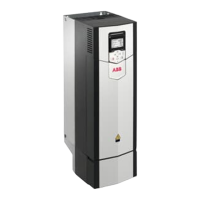Using a hexagonal motor flux vector pattern, the maximum output voltage can be
reached above the field weakening point. This increases the peak load capacity
compared to the circular pattern, but the continuous load capacity in the range
of FWP … 1.6 × FWP is reduced because of increasing losses. With hexagonal motor
flux active, the pattern changes from circular to hexagonal gradually as the
frequency rises from 100% to 120% of the FWP.
Settings and diagnostics
Parameters: 97.18 Hexagonal field weakening (page 531) and 97.19 Hexagonal field
weakening point (page 531).
Application control
■
Application macros
Application macros are predefined application parameter edits and I/O
configurations. See chapter Default control connections (page 29).
■
Mechanical brake control
A mechanical brake can be used for holding the motor and driven machinery at
zero speed when the drive is stopped, or not powered. The brake control logic
observes the settings of parameter group 44 Mechanical brake control as well as
several external signals, and moves between the states presented in the Brake
state diagram on page 97. The tables below the state diagram detail the states
and transitions. The timing diagram on page 100 shows an example of a
close-open-close sequence.
The mechanical brake control logic operates on a 10 ms time level.
Inputs of the brake control logic
The start command of the drive (bit 5 of 6.16) is the main control source of the
brake control logic. An optional external open/close signal can be selected by
44.12. The two signals interact as follows:
• Start command = 1 AND signal selected by parameter 44.12 = 0 → Request
brake to open
• Start command = 0 OR signal selected by parameter 44.12 = 1 → Request brake
to close
Another external signal – for example, from a higher-level control system – can be
connected via parameter 44.11 to prevent the brake from opening.
Other signals that affect the state of the control logic are
• brake status acknowledgement (optional, defined by 44.7),
96 Program features

